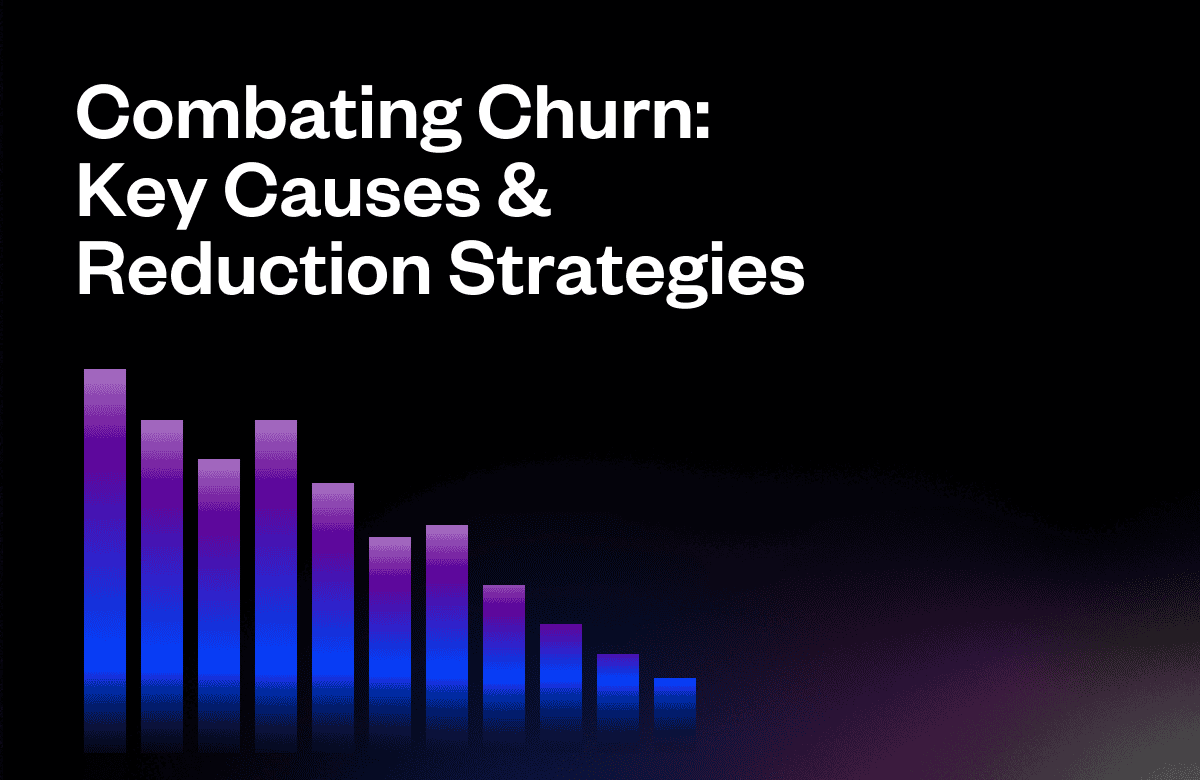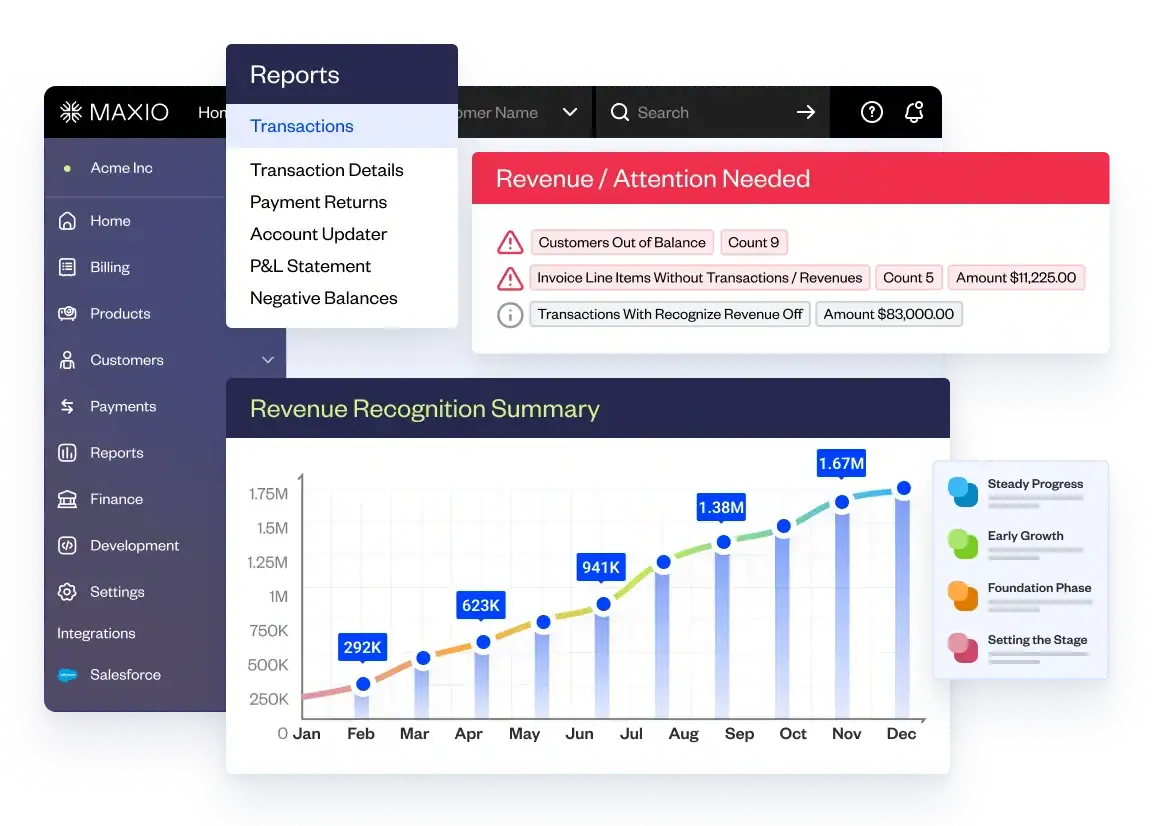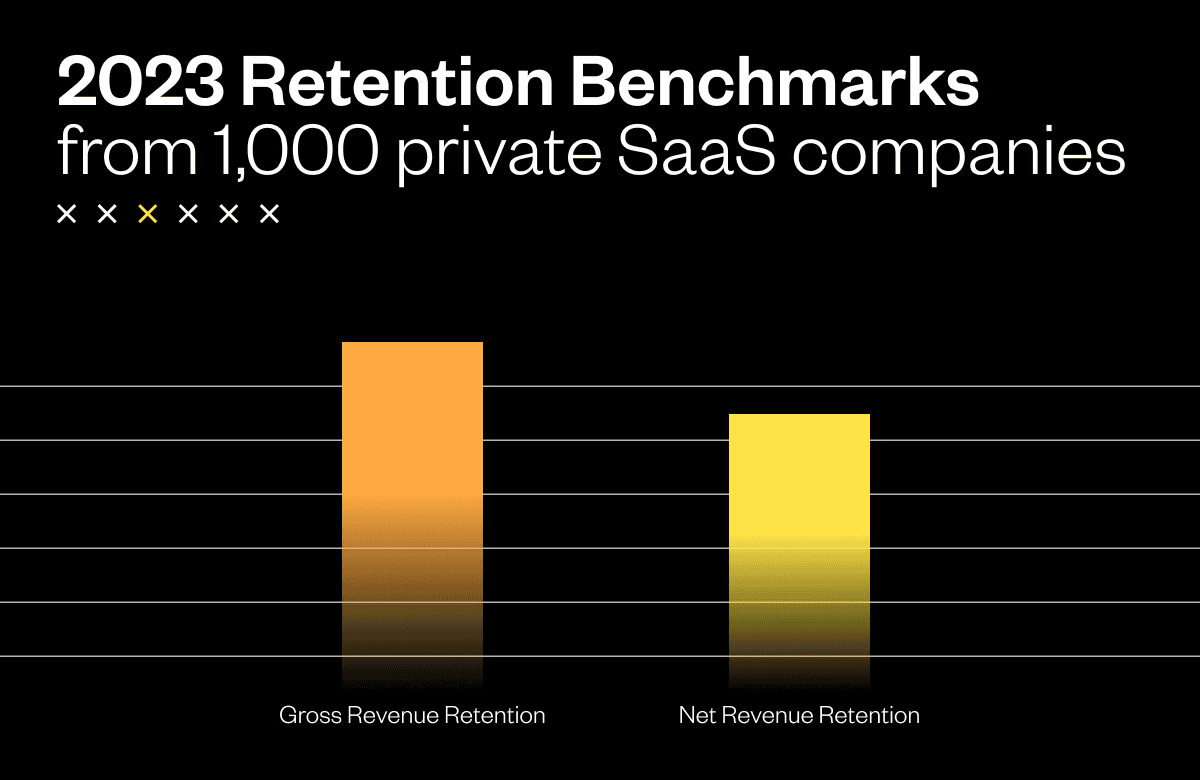If you can understand your SaaS churn rate, you’ll have everything you need to prevent revenue leakage in your SaaS company. But while a company’s customer churn rate is a relatively straightforward metric, there is a lot of important context surrounding it that you should work to understand.
How does churn rate affect your valuation? How do you calculate your churn rate? What customer activities could act as leading indicators for churn?
In this article, we’ll answer all of these questions and more. Here’s what you need to know about your SaaS churn rate.
What is Churn Rate?
So, what exactly do we mean when we refer to this churn thing? Put simply, churn is tracking how many customers you’re losing over a certain period of time. It’s a key metric that any business with repeat customers needs to monitor.
The first step to calculating churn rate calculation is defining the time frame for your analysis, whether monthly, quarterly, or annually. This could be from the start of the month to the beginning of the next month or a quarterly period from January to March. Being consistent in your chosen period will allow you to benchmark and track any churn trends over time.
Next, you’ll want to determine your MRR (monthly recurring revenue) at the start of the period. This acts as your denominator. Then count up any lost revenue from customers who canceled their subscriptions within that time frame. That canceled MRR total becomes your numerator.
To calculate the actual churn rate, divide your numerator (MRR lost) by your denominator (starting MRR) and multiply by 100 to get a percentage. This churn rate formula provides a clear metric for the portion of your customer base that was not retained for that specific period.
Keeping close tabs on churn rates through consistent calculation and churn analysis will allow you to forecast growth and spot opportunities to improve your business model. With experience, given your particular industry and customer base, you’ll establish benchmarks for what constitutes a low versus high churn rate. This data-driven approach to churn helps reduce revenue lost and supports a lower churn rate in the long term.
For instance, say you had 1,000 subscribers at the beginning of the month, but then 50 of them vanished during this given period of time. To find the monthly churn rate, you’d take 50 and divide it by the original 1,000. That would give you a 5% churn rate. This is about an average churn rate, but ideally, a good churn rate would hover around 1-2%.
A few notes — churn is always a percentage, so higher is worse. It doesn’t count one-time buyers; folks are just supposed to stick around. And the period has to be the same each time to spot trends.
By grasping this definition, subscription businesses can tally up how well they hold onto clients in the long run. In the next section, we’ll dive into why keeping a close eye on churn is so crucial to future success.
Why Churn Rate Matters
There are several compelling reasons why churn rate is an important metric for businesses to track closely. Higher churn means losing valuable recurring revenue streams when customers cancel subscriptions or downgrade their subscription tiers. It also equates to losing repeat customers and future purchases, directly impacting top-line growth and profits.
Retaining existing customers is also significantly less expensive than constantly needing to acquire new ones — specifically, in the SaaS industry, it can cost 4-5 times more to acquire new customers rather than retaining current ones. High churn can also damage a brand’s reputation by influencing potential new customers with negative reviews about product experiences online. For all of these reasons, SaaS businesses should prioritize monitoring and reducing churn over funneling their dollars into customer acquisition.
The 3 Main Causes of Churn
There are countless reasons for churn — and sometimes, it has nothing to do with your startup, offer, or service quality. That being said, there are several causes of customer churn that you can work to prevent.
Here are the three main causes of churn and what you can do to stop them.
1. Poor Customer Experience
Providing an excellent customer experience should be a top priority for SaaS companies, but poor experiences are one of the leading drivers of churn. Customers will quickly cancel a subscription or switch to a competitor if they are frustrated with usability issues, slow response times, or lack of support.
Some common pain points that cause customer churn related to poor customer experience include confusing interfaces that are difficult to navigate, too many clicks to complete basic tasks, slow load times that cause frustration, and an inability to find answers to common questions through self-service easily. A lack of available support channels or long wait times to speak with an agent also significantly damages brand perception.
2. Pricing and Promotions
Pricing is a core lever that, if not handled carefully, can drive customers away. Upfront transparency around pricing plans is key to setting expectations and avoiding churn from unexpected increases later. While temporary promotions may attract trial users, they also present risks. Customers signing up for heavily discounted introductory rates may feel misled if bills jump substantially after the trial period ends.
It’s important to communicate the ongoing pricing clearly once the promotion expires. Loyal, long-term users often pay fair rates for ongoing value. However, relying too heavily on short-term discounts that aren’t sustainable long-term can undermine retention. Promotions should balance acquisition and retention goals.
Testing different pricing tiers and add-on options can provide insights into customers’ willingness to pay for various plan levels and features. This data can then guide informed pricing strategies. Even if increases are necessary, advance notice and a demonstrated ongoing commitment to delivering value at a fair price can help curb churn.
Transparency must go both ways, too – listening to understand customer perceptions of value and affordability helps ensure prices feel appropriately set. With the right testing and communication approaches, pricing need not be a significant driver of unwanted customer losses.
3. Competition in the Marketplace
Competition in the SaaS marketplace can significantly impact customer churn, as businesses must continually deliver the best experience to maintain their user base.
Losing customers to competitors offering superior alternatives presents a major retention challenge. SaaS companies can experience churn when other options emerge that better meet customer needs through more desirable features, improved performance, lower pricing, or stronger reputations.
To curb competitive churn, SaaS leaders must closely track competitors’ positioning, ensure offerings stay innovative and aligned with trends, and proactively address issues driving customers to other providers. Through self-evaluation, commitment to excellence, and truly understanding evolving user demands, businesses can retain their competitive edge and prevent unwanted customer losses to more agile rivals.
4 Strategies to Reduce Churn
Losing customers is easy. Keeping them around is much more difficult (but it’s not impossible). You can build a ‘culture of retention’ across your organization by equipping your Sales and Customer Success teams with the right retention and marketing strategies to reduce churn risks.
Here are the strategies we recommend implementing to keep your users signed up and sticking around.
1. Gather Customer Feedback
No business knows its customers better than the customers themselves. Making it easy for clients to provide direct input about their experiences is a valuable way to gain insights into what’s working well and where improvements could be made.
Some effective methods for gathering this kind of feedback include creating surveys, focus groups, and user communities. Periodic online surveys sent to active customers and former clients who stopped using the service can shed light on their motivations. Similarly, in-person or virtual focus groups can allow your team to dive deeper into select issues with a small set of clients.
A perfect example of this is Salesforce’s “Trailblazer Community.” This platform enables users to connect, learn, and collaborate on everything related to Sales and marketing. Members can even join groups, participate in events, and help each other thrive in using Salesforce products:
(Source: https://trailhead.salesforce.com/trailblazer-community/feed)
2. Improve Your Onboarding Process
Building a seamless onboarding experience is crucial for SaaS companies that want to maximize customer retention and reduce churn. The first impressions made during this initial onboarding stage can strongly shape a customer’s longer-term engagement and likelihood of continuing their subscription.
But what exactly does an effective onboarding experience look like?
For starters, the best onboarding experiences walk users through the entire process step-by-step. This involves carefully walking customers through account setup, interactive feature tutorials, and reducing their overall time-to-value when using your SaaS.
It’s also worth noting that you don’t always need a dedicated account manager to take new users through the onboarding process. Instead, offering multiple onboarding support options can ensure all your customers’ needs are met. This could include offering short instructional videos to supplement any written documentation you have or building out an interactive tutorial that customers can work through at their own pace.
3. Personalize the Customer Experience
Collecting and analyzing information on how and where your customers spend their money across your organization is key to personalizing their experience with your SaaS. With this in mind, business leaders can gain valuable insights by tracking various metrics and KPIs across customer cohorts defined by attributes like industry, company size, role, region, or other demographic factors.
For example, monitoring metrics such as monthly recurring revenue, expansion rates, contraction rates, and churn over time helps identify cohorts whose needs may not be met. This provides direction on where to focus efforts to boost retention. For example, analytics may show revenue trends down for a certain customer base despite the approaching renewal time.
With a SaaS metrics and analytics platform like Maxio, you can take advantage of drill-down reporting features to see exactly how revenue is trending across your organization:
(Source: https://www.maxio.com/saas-metrics)
Equipped with this granular customer spending information, SaaS companies can update their product roadmaps to deliver solutions that better serve the needs of at-risk customer cohorts. Similarly, you can offer custom features, pricing plans, and onboarding processes specifically designed to address your customers’ pain points and reduce their likelihood of churn.
4. Test and Measure New Customer Retention Strategies
Similar to personalization, continually testing and optimizing approaches to product development, customer support, and account management are all key to reducing churn over the long run.
To do this, consider implementing A/B testing of your pricing and billing methods, onboarding, or renewal workflows with separate customer cohorts. Then, carefully track metrics like your conversion rates, activation times, and user retention over a monthly or quarterly basis to see how these tests impact your business’s overall health. For example, offering personalized discounts significantly increases renewal conversions versus sending generic reminders a week or a month before they occur.
Regardless of the tests you run, maintaining this ‘testing mindset’ ensures that you’ll continue to create a better user experience for your customers and improve customer lifetime values across your customer base.
The Importance of Predicting At-Risk Customers
To best support your customers throughout their lifecycle, it’s important to identify users who are showing signs of potential churn. Some churn-risk indicators to monitor include usage patterns, engagement signals, and financial behaviors.
For instance, tracking customer logins and product usage over time can reveal declining activity levels that suggest they are no longer getting value out of your product or that your product is just a nice-to-have in their tech stack. A sudden drop-off in core product usage could also indicate that a customer is exploring alternatives to your solution (AKA your competitors). It’s also wise to consider certain spending behaviors like unpaid invoices or stalled subscription renewals. Missing a payment may not guarantee that a customer will churn, but it’s a warning sign that should prompt your customer success managers to step in and investigate.
Most importantly, intervening is key. By monitoring these types of at-risk indicators across your customer base, you can proactively contact potentially churning customers to ensure their needs are met before they switch providers.
Measuring Retention Programs: Why You Should Do It and How
While taking proactive steps to retain at-risk customers is important, measuring the ROI of your anti-churn initiatives is equally crucial. Without tracking these results, you won’t know which programs are truly helping to curb your customer losses.
Calculating the expense of running specific retention programs against the number of customers kept can help you gauge their return. For example, if a targeted email campaign costs $5,000 and saves five customers from churning, the cost per the total number of customers that were retained is $1,000 — this could be a worthwhile ROI if those current customers renew for multiple years.
Similarly, you should track your overall monthly or annual churn rates before and after implementing these retention tactics and see what kind of results you’re getting. Did your customer attrition rate decrease from 5% to 2% after launching a new success manager role? That 3% reduction could translate to significant recurring revenue retention depending on the size of your customer base and their average contract value (ACV).
Remember that qualitative metrics also provide valuable insights. Survey retained at-risk customers to determine which interventions helped them most — a price adjustment, new features, or personalized support.
Ultimately, it will take the combined efforts of your entire go-to-market departments (Sales, Marketing, Customer Success, Growth) to ensure your retention programs are a success — but by continuously tracking hard ROI metrics and customer satisfaction indicators, you start to build an effective system to tackle any customer churn-risks that occur across your user base.
Don’t Go Overboard Trying to Eliminate Churn
One last thing before we wrap this up — if you’re too narrowly focused on reducing churn over the next month or quarter, you could hurt your business over the long term. Of course, keeping customers from churning quarter-to-quarter is crucial (we’re not arguing against that). Still, it’s even more valuable to address customer churn in a way that cultivates long-lasting, mutually beneficial relationships.
With this long-term perspective in mind, the most optimal strategy is often to balance your acquisition efforts with prioritizing customer retention. After all, a healthy retention rate is one of the key inputs investors use to calculate valuation metrics like The Rule of 40. In other words, focusing on retention over time could lead to a bigger eventual exit.
But don’t get us wrong, there are times when focusing almost exclusively on lead generation makes sense — for example, investing heavily in acquiring new customers makes sense if their predicted lifetime value exceeds your customer acquisition costs (CAC). However, once your customer base is established (typically after your Series A if you’re VC-backed), shifting more of your funds towards user retention can help increase your company’s total valuation and bottom line over time.
Improve Your User Retention with Maxio
Want to prevent revenue leakage and stop throwing dollars into a customer acquisition money pit? With Maxio, you can see exactly how revenue trends across your organization and drill down into customizable reports for individual customer cohorts, product lines, and business segments.
Schedule a demo with our team to get started.





